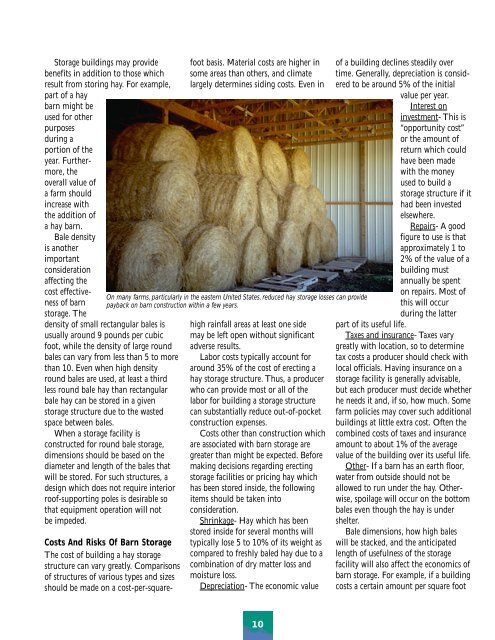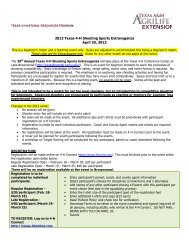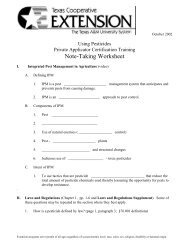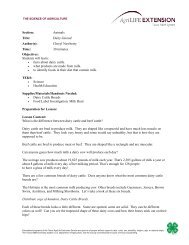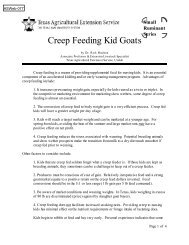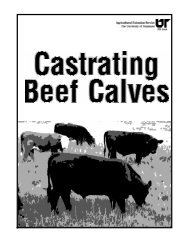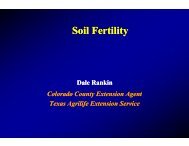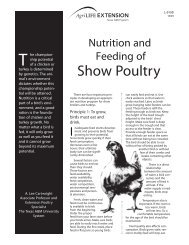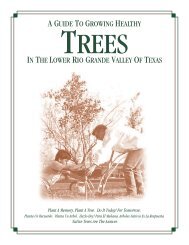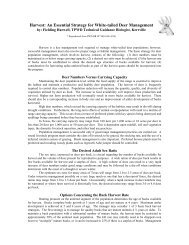<strong>Storage</strong> build<strong>in</strong>gs may providebenefits <strong>in</strong> addition to those whichresult from stor<strong>in</strong>g hay. For example,part of a haybarn might beused for otherpurposesdur<strong>in</strong>g aportion of theyear. Furthermore,theoverall value ofa farm should<strong>in</strong>crease withthe addition ofa hay barn.Bale densityis anotherimportantconsiderationaffect<strong>in</strong>g thecost effectivenessof barnstorage. Thedensity of small rectangular bales isusually around 9 pounds per cubicfoot, while the density of large roundbales can vary from less than 5 to morethan 10. Even when high densityround bales are used, at least a thirdless round bale hay than rectangularbale hay can be stored <strong>in</strong> a givenstorage structure due to the wastedspace between bales.When a storage facility isconstructed for round bale storage,dimensions should be based on thediameter <strong>and</strong> length of the bales thatwill be stored. For such structures, adesign which does not require <strong>in</strong>teriorroof-support<strong>in</strong>g poles is desirable sothat equipment operation will notbe impeded.Costs And Risks Of Barn <strong>Storage</strong>The cost of build<strong>in</strong>g a hay storagestructure can vary greatly. Comparisonsof structures of various types <strong>and</strong> sizesshould be made on a cost-per-squarefootbasis. Material costs are higher <strong>in</strong>some areas than others, <strong>and</strong> climatelargely determ<strong>in</strong>es sid<strong>in</strong>g costs. Even <strong>in</strong>On many farms, particularly <strong>in</strong> the eastern United States, reduced hay storage losses can providepayback on barn construction with<strong>in</strong> a few years.high ra<strong>in</strong>fall areas at least one sidemay be left open without significantadverse results.Labor costs typically account foraround 35% of the cost of erect<strong>in</strong>g ahay storage structure. Thus, a producerwho can provide most or all of thelabor for build<strong>in</strong>g a storage structurecan substantially reduce out-of-pocketconstruction expenses.Costs other than construction whichare associated with barn storage aregreater than might be expected. Beforemak<strong>in</strong>g decisions regard<strong>in</strong>g erect<strong>in</strong>gstorage facilities or pric<strong>in</strong>g hay whichhas been stored <strong>in</strong>side, the follow<strong>in</strong>gitems should be taken <strong>in</strong>toconsideration.Shr<strong>in</strong>kage- <strong>Hay</strong> which has beenstored <strong>in</strong>side for several months willtypically lose 5 to 10% of its weight ascompared to freshly baled hay due to acomb<strong>in</strong>ation of dry matter loss <strong>and</strong>moisture loss.Depreciation- The economic valueof a build<strong>in</strong>g decl<strong>in</strong>es steadily overtime. Generally, depreciation is consideredto be around 5% of the <strong>in</strong>itialvalue per year.Interest on<strong>in</strong>vestment- This is“opportunity cost”or the amount ofreturn which couldhave been madewith the moneyused to build astorage structure if ithad been <strong>in</strong>vestedelsewhere.Repairs- A goodfigure to use is thatapproximately 1 to2% of the value of abuild<strong>in</strong>g mustannually be spenton repairs. Most ofthis will occurdur<strong>in</strong>g the latterpart of its useful life.Taxes <strong>and</strong> <strong>in</strong>surance- Taxes varygreatly with location, so to determ<strong>in</strong>etax costs a producer should check withlocal officials. Hav<strong>in</strong>g <strong>in</strong>surance on astorage facility is generally advisable,but each producer must decide whetherhe needs it <strong>and</strong>, if so, how much. Somefarm policies may cover such additionalbuild<strong>in</strong>gs at little extra cost. Often thecomb<strong>in</strong>ed costs of taxes <strong>and</strong> <strong>in</strong>suranceamount to about 1% of the averagevalue of the build<strong>in</strong>g over its useful life.Other- If a barn has an earth floor,water from outside should not beallowed to run under the hay. Otherwise,spoilage will occur on the bottombales even though the hay is undershelter.Bale dimensions, how high baleswill be stacked, <strong>and</strong> the anticipatedlength of usefulness of the storagefacility will also affect the economics ofbarn storage. For example, if a build<strong>in</strong>gcosts a certa<strong>in</strong> amount per square foot10
Breakeven barn cost ($/sq. ft)to build, but bales will be stacked threehigh <strong>and</strong> the facility is expected to lastfor 20 years, the cost per square footfor bale storage per year (constructioncost only) can be determ<strong>in</strong>ed bydivid<strong>in</strong>g the construction cost by 3 <strong>and</strong>then by 20. The cost/bale/year canthen be obta<strong>in</strong>ed by multiply<strong>in</strong>g thecost per square foot by the squarefootage of the size of bales to be stored(for example, a 5 foot x 6 foot balewill occupy about 30 square feet ofstorage space).In the f<strong>in</strong>al analysis, <strong>in</strong> order todeterm<strong>in</strong>e whether it is economicallyfeasible to build a hay storage structurea producer must calculate anticipatedconstruction costs, then compare thisfigure with an estimate of the value ofhay be<strong>in</strong>g lost without it. Figure 2provides the break even costs for barnconstruction at various loss levels,costs/square foot, <strong>and</strong> hay values.252015105Outside storage loss = 25%040 50 60 70 80 90 100 110 120Average spoilage depth (<strong>in</strong>ches)Figure 2. Break even barn cost for various levels ofstorage loss <strong>and</strong> vary<strong>in</strong>g hay value at harvest.(This analysis <strong>in</strong>cludes the follow<strong>in</strong>g assumptions: <strong>in</strong>-barnaverage stack<strong>in</strong>g height of three bales, ten-year barnamortization, <strong>and</strong> construction cost of $7.50/square foot.Inputs other than storage loss <strong>and</strong> hay value arenot <strong>in</strong>cluded.)SOURCE: Buckmaster, D.R. 1993. Evaluator for Round<strong>Hay</strong> Bale <strong>Storage</strong>. J. Prod. Agric., 6:378-385.20%15%10%Table 5. Average <strong>and</strong> range of <strong>in</strong>crease of percentages of dry matter <strong>and</strong>digestible dry matter with barn storage as compared to various protectiontechniques used for hay stored outside. (Medium ra<strong>in</strong>fall areas.)*Increase With Barn <strong>Storage</strong>, % UnitsTreatment Compared To Barn <strong>Storage</strong> Dry Matter Digestible Dry MatterOn Ground Without Cover 8.7 12.7(3.6 - 14.5) 1 (3.3 - 17.2)Dra<strong>in</strong>ed Surface (Rock, Pallets, etc.) 2.4 6.8(-1.3 - 6.7) (-0.4 - 13.4)Plastic Cover On Bale Tops 3.2 3.6(0.6 - 4.6) (2.9 - 4.3)Dra<strong>in</strong>ed Surface + Plastic Cover 0.3 -1.4On Bale Tops (0.9 - 2.9) (-2.1 - 1.8)Net Wrap 1.5 —(0.6 - 1.5) —Plastic Sleeve 0.6 —(-1.4 - 2.7)Pyramid Stack + Cover On Top 3.7 —*SOURCE: Russell, Jim, <strong>and</strong> Ray Huhnke. 1997. W<strong>in</strong>ter Feed Management To M<strong>in</strong>imize Cow-Calf ProductionCosts: <strong>Hay</strong> <strong>Storage</strong> And Feed<strong>in</strong>g. The Forage Leader (a periodical published by the American Forage <strong>and</strong>Grassl<strong>and</strong> Council, Georgetown, TX). 1 Parentheses denote the range of values <strong>in</strong> tests <strong>in</strong>cluded <strong>in</strong> this summary.The costs versus the benefits ofus<strong>in</strong>g other techniques to protect hayshould be compared to: (1) hay storedoutside with no protection, <strong>and</strong> (2)build<strong>in</strong>g a hay storage facility. Experimentshave generally shown that morethan half (<strong>and</strong> sometimes nearly all)the difference <strong>in</strong> storage lossesbetween outside storage on theground with no protection <strong>and</strong>barn stored hay can be elim<strong>in</strong>atedthrough the use of variousstrategies. A summary of 12experiments compar<strong>in</strong>g storagelosses of barn stored hay tovarious other storage techniquesis provided <strong>in</strong> Table 5.Barn Safety ConsiderationsSafety considerations should be ahigh priority when plann<strong>in</strong>g barnstorage of hay. These <strong>in</strong>clude mak<strong>in</strong>gcerta<strong>in</strong> that equipment available on thefarm is capable of safely plac<strong>in</strong>g bales<strong>in</strong> stable stacks, hav<strong>in</strong>g a shield onstack<strong>in</strong>g equipment to prevent <strong>in</strong>juryto the operator if a bale falls, <strong>and</strong>mak<strong>in</strong>g certa<strong>in</strong> that excessive pressurewill not be exerted on the walls orsupports of the storage facility(stack<strong>in</strong>g bales on end reduces thelatter hazard).11REDUCING FIRE RISKEach year there are many reports of haybarns burn<strong>in</strong>g, as well as of firesoccurr<strong>in</strong>g <strong>in</strong> hay stored outside. Fire isalways a concern with hay, but it takeson even greater importance when anexpensive barn can be lost <strong>in</strong> additionto the hay.Fire <strong>in</strong> stored hay may occur fromeither external or <strong>in</strong>ternal causes.Internally started fires are a result ofhay go<strong>in</strong>g through an extreme heat.As discussed earlier, heat<strong>in</strong>g is a directresult of microorganism activity <strong>in</strong> haystored at excessively high moisturelevels. Even if excessive heat<strong>in</strong>g doesnot result <strong>in</strong> a fire, it will reduceforage quality.Combustion Due ToExtreme Heat<strong>in</strong>gThe pr<strong>in</strong>cipal way to avoid fire result<strong>in</strong>gfrom <strong>in</strong>ternal heat<strong>in</strong>g (sometimesreferred to as “spontaneous combustion,”though this term is mislead<strong>in</strong>g)is to bale hay at proper moisture levels.<strong>Hay</strong> <strong>in</strong> round bales should conta<strong>in</strong> nomore than 18% moisture when placed<strong>in</strong>side a barn, while hay <strong>in</strong> smallrectangular bales should conta<strong>in</strong> nomore than 20% moisture. <strong>Hay</strong> that is


